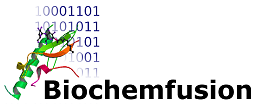Biochemfusion documents and presentations
PLN Guide
A short document that helps you write correct PLN.
White papers
- Creating readable protein SAR tables through consistent naming
Biochemfusion's DerNot notation defines a convenient protein naming scheme that is both human- and machine-readable. Together with Biochemfusion's Protein Line Notation you have the tools to create readable protein SAR tables with consistent and chemically precise names.
Presentations
- PYPL - a cartridge that enables Python functions, and thereby RDKit, in Oracle databases
The Open Source cheminformatics toolkit RDKit has been integrated into various environments, e.g. KNIME and PostgreSQL. One place where it has been missing so far is in Oracle databases. The PYPL cartridge allows developers to run arbitrary Python code from within Oracle PL/SQL. The full RDKit API can be accessed via Python modules and so PYPL enables advanced cheminformatics capabilities in Oracle databases.
This presentation is from the 2014 RDKit User Group Meeting hosted by Merck in Darmstadt, Germany. - Fast structure keys for large molecules - poster at ICCS 2014, Noordwijkerhout, The Netherlands
Very large molecules cannot easily be assigned a unique structure key via standard means. This poster shows an approach that makes it possible to calculate unique structure keys for large proteins in a matter of milliseconds, even when taking chemical or post-translational modifications into account. The mechanism builds on top of the standard InChI identifier for small molecules.
The poster was created in collboration with Gerd Blanke, StructurePendium, and presented by Gerd Blanke at ICCS 2014. - Partner presentation at the ChemAxon European UGM 2014
This year's partner presentation is focused on peptide and protein registration. Biochemfusion has entered into a joint collboration with the danish biotech company Zealand Pharma to develop a new peptide registration system based on Proteax. The presentation shows current progress of the project which will go live on June 30th 2014. - Partner presentation at the ChemAxon European UGM 2013
Shows how peptides and proteins can be edited in Microsoft Excel with Proteax for Spreadsheets, either via a sequence tool or via MarvinSketch. Proteax will automatically translate back and forth between sequence and structure. The recently released KNIME nodes are announced with an example of how they can be used to make peptide PubChem structures easier to interpret. - Finding unusual peptides on the Internet using plain three
letter sequence codes - ECCB 2012
AKos Global Search - the internet search engine for chemists - is using Proteax, both as a query front-end (the Proteax PLN editor) and for powerful back-end analytics with complete round-trip engineering. Chemical databases can be searched based on standard three-letter sequence queries, and search results from e.g. PubChem or ChEBI can be compared by sequence even though the returned search results are chemical structures. - RDKit UGM 2012 - running RDKit on a Raspberry Pi
A simple walkthrough showing the slight gotchas that you have to workaround to get RDKit compiled on a Raspberry Pi. - Partner presentation at the ChemAxon European UGM 2012
Searching for modified peptides and proteins on the internet can be challenging. This presentation shows how the combination of Biochemfusion's Proteax toolkit and AKos's Global Search engine lets you search chemistry databases like PubChem by sequence. The search results are furthermore analyzed using a combination of Proteax and ChemAxon's JChem for Excel; search results are mapped meaningfully back into peptide sequences for easier comparison and visualization. - Informatics UGM at MipTec 2011, Basel, Switzerland
When protein variants are listed in SAR tables their full sequences or full structures contain too much detail to be of much practical use. By using Biochemfusion's Proteax software to generate consistent protein names you can however generate readable SAR tables. This presentation presents an actual database system that generates protein SAR tables via calculated protein names. The system even retains the underlying chemistry so modified proteins can be found via standard molecular queries. - ICM 2011 in Beijing, China
A prevailing industry trend is to put less emphasis on traditional small-molecule medicinal chemistry and start designing drugs based on peptides and proteins. However, current life science IT systems are usually not prepared to handle these larger molecules. This presentation discusses how peptides and proteins can be efficiently represented in a way that is compatible with both small-molecule systems and normal bioinformatics tools. - Partner presentation at the ChemAxon European UGM 2011
The "Marvin and JChem + Proteax" presentation shows how vendors are using Proteax together with the ChemAxon toolkits to provide unique solutions. - Partner presentation at the ChemAxon European UGM 2010
The "Interfacing to JChem for Excel" presentation demonstrates how you can manipulate peptides in Excel with Proteax for Spreadsheets and transfer them directly to ChemAxon's JChem for Excel to calculate pI values.
Specifications - Biomolecular representation
- Protein Line Notation (PLN) specification - Version 1.4 2015-02-20.
- Protein Derivatives Notation (DerNot) specification - Version 1.1 2014-01-19.
- Binary molfile-equivalent format for 2D molecules - Version 1.0 2012-12-18.
- Condensed chemical representation - with example structures.
Older versions
- Protein Line Notation (PLN) specification - Version 1.3 2013-05-08.
- Protein Line Notation (PLN) specification - Version 1.2 2011-12-07.
- Protein Line Notation (PLN) specification - Version 1.1 2009-10-14.
- Protein Line Notation (PLN) specification - Version 1.0 2008-11-28.
- Protein Derivatives Notation (DerNot) specification - Version 1.0 2009-10-23.
Graphical rendering format documentation
Spreadsheet add-ins
- OpenOffice.org Calc Add-in How-To. Describes how to build a spreadsheet add-in for OpenOffice.org Calc. Python-based simple example.
Product sheets / Product flyers
- Proteax for Spreadsheets product flyer, May 2013.
- Proteax KNIME™ nodes product flyer, May 2013.
- Proteax Cartridge product flyer, May 2012.

